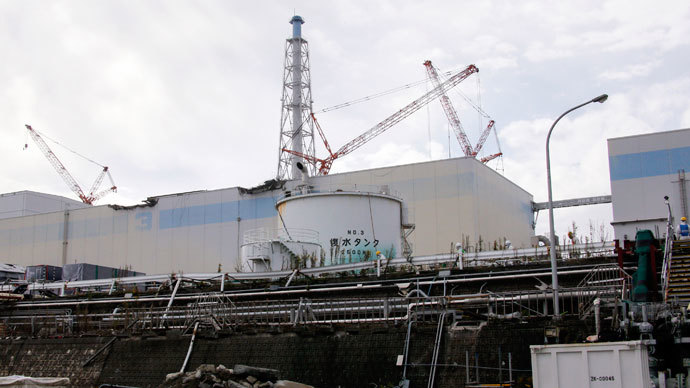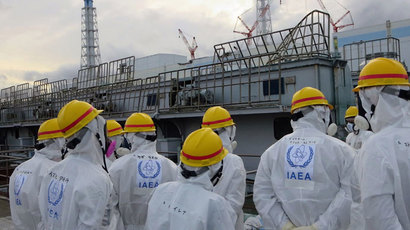TEPCO to siphon off radioactive water from tunnels under Fukushima plant

The operator of Japan’s crippled Fukushima Daiichi atomic plant plans to start cleaning underground tunnels believed to be part of the sources of radioactive materials poisoning the groundwater in the area.
The Tokyo Electric Power Company (TEPCO) will first block the
flow of tainted water between the damaged buildings and the
tunnels. Workers will begin burying pipes in the ground to carry
refrigerants in January, NHK TV network reported. In April, they
are set to start draining the contaminated water from the
tunnels.
Late last month, TEPCO said it had found new leaks at the No. 1
reactor, in addition to the previous ones discovered last earlier
in December. The latest incident on December 24 may have leaked
around 225 tons of radioactive water, Japan Daily Press reported.
It turned out that the water in that area contained Strontium-90,
a radioactive isotope of strontium produced by nuclear fission
with a half-life of 28.8 years, at a level as high as 440
becquerels per liter. The current temporary limit for water to be
released from the concrete boundaries is said to be 10 becquerels
of Strontium-90 per liter. A TEPCO representative feared the
water may have already seeped into the ground.
On December 21, Tepco said it had
found a record 1.9 million becquerels per liter of beta
ray-emitting radioactive substances at its No.2 reactor, the
highest since the nuclear meltdown in March 2011. The discovery
was made after high levels of radioactive cesium were detected in
deeper groundwater at the No. 4 reactor. Previously, the highest
level recorded was 1.8 million becquerels at the No. 1 reactor on
December 13. It's believed that the radioactivity in the
groundwater at reactor No. 2 has been rising since November.
Since the outbreak of the Fukushima disaster in March 2011,
leakage of radiation-contaminated water has been the major threat
to Japan’s population and environment, as well as to the
international community.
The chairwoman of the US Nuclear Regulatory Commission warned
last month that water exposed to radiation from the wrecked plant
would soon reach the US.
"The highest amount of radiation that will reach the US is of two
orders of magnitude – 100 times – less than the drinking water
standard," Allison Macfarlane told Bloomberg. "So, if
you could drink the salt water, which you won’t be able to do,
it’s still fairly low."
According to Ken Buesseler, a senior scientist at the Woods Hole
Oceanographic Institution, radiation released during explosions
at the plant meltdowns and during subsequent leaks of
contaminated underground water will reach mainland US shores by
early 2014.
The San Francisco Bay area city of Fairfax, California, passed a
resolution in early December calling for more testing of coastal
seafood and ways to reduce radiation emissions from Fukushima.

On December 4, the UN nuclear watchdog, the International Atomic
Energy Agency (IAEA), advised the Fukushima Daiichi nuclear power
plant to consider dumping toxic water into the ocean after
lowering the level of radioactive materials to below the legal
limit. Meanwhile, according to a draft report released by
officials on the Japanese Industry Ministry's contaminated water
panel, the Fukushima Daiichi plant could run out of storage space
for contaminated water within two years. The report suggested
covering the ground with asphalt to reduce the rain inflow and
building giant tanks with more capacity, as well as installing
special undersea filters to reduce the radioactivity of water
that leaks into the sea. Currently, 400 metric tons of highly
contaminated water is being produced at the site on a daily
basis, much of it later flowing to the sea.
To tackle the problem, TEPCO has been running a test operation of
an advanced water processing
machine, known as ALPS, which can remove all radioactive
materials except for tritium from tainted water. Its operation
could be key to reducing the high levels of radiation in the
water. TEPCO plans to clean up all of the tainted water through
ALPS by the end of March 2015. It says that over 300,000 tons of
radioactive water has been stored in 1,000 tanks at the Fukushima
plant, and that the amount will double within a few years.
In July 2013 TEPCO acknowledged the fact that contaminated water
has been escaping from basements and trenches of the Fukushima
plant into the ocean. Since then, the operator reported two major
leaks of highly radioactive water into the ocean from storage
tanks – a 300-ton leak in August and 430 liters in October.
Major setbacks have stalled TEPCO's handling of the nuclear
disaster amid widespread criticism and calls to put
Fukushima-related work under government control. Earlier this
week a former employee in the facility said that one of the
reasons for so many leaks could be the cost-cutting measures
applied by TEPCO, such as using duct tape and wire nets to mend
the leaking tanks.














